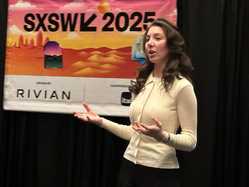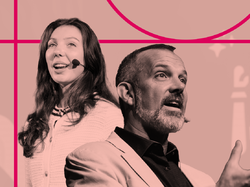The marvelous Design of AI podcast features a conversation with Big Medium’s Josh Clark and Veronika Kindred about Sentient Design and the already here future of intelligent interfaces. Along with hosts Brittany Hobbs and Arpy Dragffy, Josh and Veronika discuss AI as a design material—the hows, whys, and implications of using machine intelligence to create radically adaptive, context-aware digital experiences.
And friends, they get into it. The conversation highlights the importance of design in shaping machine-intelligent experiences, focusing on outcomes and human need over technology.
Josh and Veronika address the challenges and opportunities for using machine intelligence in various domains, from healthcare to education to consumer products. They also explore ethical considerations, the need for productive skepticism, and how to raise the bar for our expectations and experiences of AI-powered interfaces. And not least, the dad-daughter pair also dig into generational perspectives about this new technology—and why old heads like Josh need young heads like Veronika to escape calcified assumptions.
And no kidding, lots more:
- The types of intelligent experiences that generative AI enables
- Moving beyond the chatbot: Where AI-powered interfaces go next
- Role of designers in shaping the next generation of digital products
- Types of relationships Gen Z and Gen Alpha will have with machine intelligence
- Should this be a period of optimism or skepticism?
What they said
A few highlights to get you started:
Josh: “The flurry around AI has been on the low-hanging fruit of productivity, and I think that there’s something that is bigger—a more meaningful transformation of experience —that is afoot here."
Josh: “We are already used to this idea of radically adaptive _content_—Netflix, Amazon, these prediction or recommendation features that are so familiar that they seem almost boring. The opportunity now is to say, oh wait, we can do that with UX now."
Josh: "We are used to designing the happy path as designers. There’s a set of interactions and data over which we have complete control. We set up the levers and the knobs and the dials for people to turn, and we know the path that they’re going to follow. But once you start having machine-intelligent experiences where the system is mediating this, you don’t have that control anymore, which means that the design experience shifts from creating this static experience to something that is much more responsive.”
Veronika: "I’ve been surprised by how many of these products are put to market that just don’t work, or really don’t do what they promise to do. Maybe you can get one idea to be conceptualized out of it, but you can’t take it to the next level at all. It just completely falls apart when you try to initiate any sort of feedback loop. That’s been my my biggest surprise: just how fast people are rushing to get these products out of the gate when they are not good enough yet.”
Josh: “I’m a big fan of getting rid of the sparkles like I think that all that that’s doing is saying, ‘this is going to be weird and broken.’ Let’s instead think: we’re making a thing that is going to work, and we should present it to the user as any other technology. It’s just software, after all. It’s not magic. It’s just software.”
Josh: “How do we lean into that weirdness as an asset instead of as a liability? Because we can’t fix it being a liability."
Veronika: “I think the more you engage, the more skepticism you should bring. If your expectations are low, you can be so happy when you’re wrong.”
Josh: “One of the things that Veronika and I are trying to do with Sentient Design is not only show how you can build new kinds of experiences and products and interactions , but also: how do you lean into the better part of this and not go into the fears around this? How do we create experiences that amplify judgment and agency instead of replace them?”
Veronika: “I kind of got the sense that AI is not so much a huge force for good or bad in the world. It’s more like oil. It helps people heat their home and drive their cars, but it also is a great tool for both equality and inequality.”
Josh: “When you ask, you know, what’s a cutting edge application? I would say it’s not even a technology application. It’s a mindset application. What kind of world do we want to design for with this? And that’s what we talk about when we talk about sentient design. Let’s let the designers be sentient and mindful about what we can do with this technology.”
Veronika: “We should raise our standards and really see that this is the moment for designers to become the ultimate mediator for users’ needs.”





